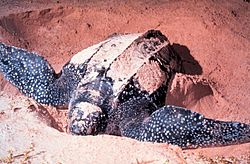Las Baulas de Guanacaste National Marine Park is a park that's 95% underwater and is a critical nesting habitat for leatherback sea turtles. The park is on the Pacific coast in Guanacaste (a province of Costa Rica). The park will be most interesting to naturalists who want to save sea turtles, though birdwatchers will enjoy spotting some of the 174 species of birds who live along the shores and adjacent swamps and forests. Surfers will get an adrenaline rush riding the waves offshore.

Understand
[edit]This is a marine park because it comprises 167 square kilometers of sea surface area but less than 8 square kilometers of land surface. The land surface is mostly white sandy beach and its adjacent mangrove swamps and tropical forest. The park was created as part of the Costa Rica national parks system in 1991 with newly protected areas and incorporating some already protected areas, such as the former Tamarindo National Wildlife Refuge. The park is a designated Ramsar wetland.
Landscape
[edit]
Most of the park is ocean surface but there are three types of landscape in the park:
- Beaches: The park includes four distinct beach areas known as Playa Carbón, Playa Ventanas, Playa Grande and Playa Langosta. The beaches are nesting areas for sea turtles and are home to a large number of shorebirds.
- Mangrove swamps: The park includes the mouth of the Rio Matapalo and the mouth of the Rio San Francisco. Thick groves of mangrove are in these areas and provide habitat for crocodiles and several kinds of shorebirds. Mangrove swamps are an ideal home for fish, crustaceans, and mollusks.
- Tropical forest: The forests that abut the beaches are home to a number of mammals and reptile species as well as providing habitat for woodland birds.
Flora and fauna
[edit]
The park was established primarily to preserve sea turtle nesting areas. The park is the largest nesting area on the Pacific coast for the endangered leatherback turtle. At least three other types of sea turtle also nest on the park's beaches.
Climate
[edit]Get in
[edit]By plane
[edit]The nearest major airport is Liberia International Airport (LIR IATA). From the airport, rent a car or take a taxi. It is about 75 minutes to drive to the nearby town of Tamarindo. Private transfers or shared shuttles can also be arranged from the Liberia airport. Liberia receives flights from San Jose (SJO IATA) as well as international flights from several U.S. hubs including Houston and Atlanta.
By bus
[edit]The bus ride from San José costs US$14 leaving Alfaro Station. The bus stops frequently and the trip takes 6-7 hours but there is much to see throughout Costa Rica. Purchase tickets at least 2 hours in advance as buses often sell out. From Liberia, there are buses every couple of hours, fare is a couple of U.S. dollars. Buses stop frequently to pick up or discharge passengers.
Fees and permits
[edit]Get around
[edit]Walk the beaches or use a surfboard to paddle around the waters offshore.
See
[edit]Do
[edit]- Surfing
- Birdwatching
Buy, eat, and drink
[edit]The park is primarily protected natural reserves. Anything you need can be purchased in the nearby town of Tamarindo or bring it with you (and take your garbage back out when you leave).
Sleep
[edit]Tamarindo is also a good place to find hotels and inexpensive hostels. There are also several hotels on Playa Grande (that were built before the national park was established). There are also a few private homes that can be rented via AirBnB. Hotels include:
- 1 Hotel las Tortugas, Santa Cruz, Refundones, ☏ +506 8856 4424. Check-in: 3PM, check-out: noon. Small hotel with air conditioning, on-site restaurant and swimming pool. Laid back vibe.
- 2 Rip Jack Inn, Santa Cruz, Refundones, ☏ +506 6474 5425. Check-in: 2PM, check-out: 11AM. Small hotel with available villas, about 100 m to beach. Swimming pool with shaded chairs. On-site restaurant and bar.
